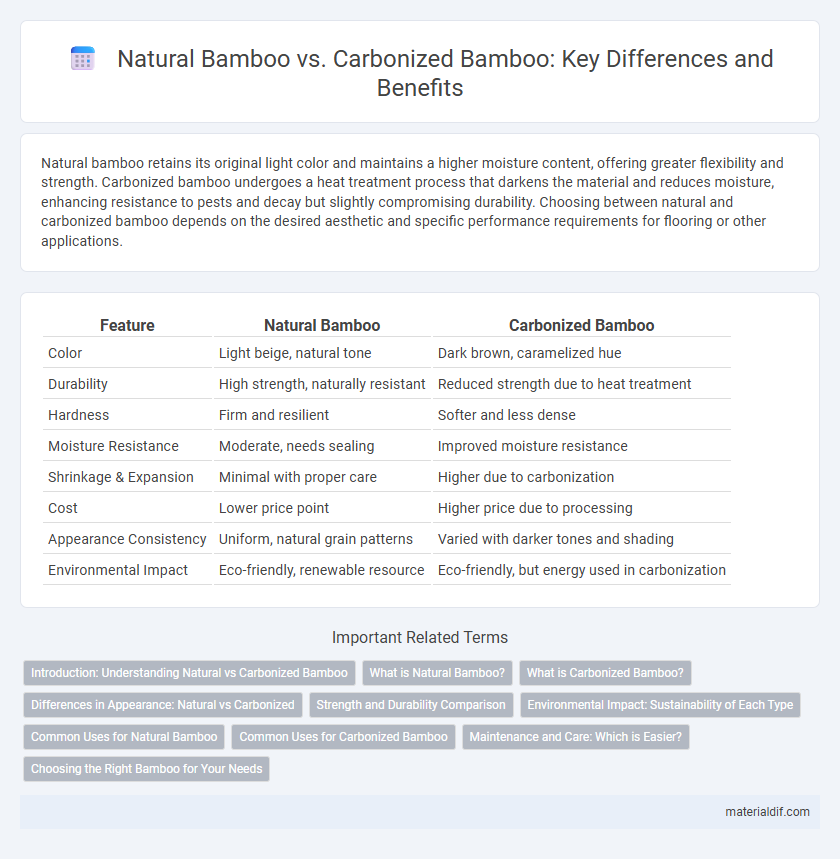Natural bamboo retains its original light color and maintains a higher moisture content, offering greater flexibility and strength. Carbonized bamboo undergoes a heat treatment process that darkens the material and reduces moisture, enhancing resistance to pests and decay but slightly compromising durability. Choosing between natural and carbonized bamboo depends on the desired aesthetic and specific performance requirements for flooring or other applications.
Table of Comparison
| Feature | Natural Bamboo | Carbonized Bamboo |
|---|---|---|
| Color | Light beige, natural tone | Dark brown, caramelized hue |
| Durability | High strength, naturally resistant | Reduced strength due to heat treatment |
| Hardness | Firm and resilient | Softer and less dense |
| Moisture Resistance | Moderate, needs sealing | Improved moisture resistance |
| Shrinkage & Expansion | Minimal with proper care | Higher due to carbonization |
| Cost | Lower price point | Higher price due to processing |
| Appearance Consistency | Uniform, natural grain patterns | Varied with darker tones and shading |
| Environmental Impact | Eco-friendly, renewable resource | Eco-friendly, but energy used in carbonization |
Introduction: Understanding Natural vs Carbonized Bamboo
Natural bamboo retains its original pale color and moisture content, offering superior strength, durability, and resistance to warping without chemical alteration. Carbonized bamboo undergoes heat treatment, resulting in a darker hue and softer texture but reduced hardness and density compared to natural bamboo. Understanding these material differences is essential for applications in flooring, furniture, and construction to ensure performance and longevity.
What is Natural Bamboo?
Natural bamboo is harvested directly from bamboo stalks without undergoing heat treatment or chemical alteration, preserving its original color, texture, and moisture content. This untreated bamboo retains higher strength and flexibility compared to carbonized bamboo, which is heat-treated to achieve a darker color but becomes slightly softer and less durable. Natural bamboo is prized for its eco-friendliness, sustainable growth, and superior mechanical properties, making it ideal for construction, flooring, and furniture applications.
What is Carbonized Bamboo?
Carbonized bamboo is heat-treated bamboo subjected to high temperatures to enhance its color and appearance, resulting in a darker, richer hue compared to natural bamboo. This thermal treatment alters the sugar and starch content, making carbonized bamboo more resistant to pests and moisture but slightly less durable than natural bamboo. The process improves aesthetics and resistance but requires careful quality control to maintain strength and longevity.
Differences in Appearance: Natural vs Carbonized
Natural bamboo features a light, creamy-yellow color with natural variations and fine patterns, preserving its original texture. Carbonized bamboo undergoes heat treatment that darkens its color to a rich, caramel or brown tone, enhancing its visual warmth but slightly softening its texture. The carbonization process also highlights the grain patterns more distinctly, creating a more uniform and polished appearance compared to natural bamboo.
Strength and Durability Comparison
Natural bamboo exhibits superior strength and flexibility due to its dense fiber composition, making it highly resistant to impact and pressure. Carbonized bamboo undergoes heat treatment which enhances its color and reduces moisture content but slightly decreases its tensile strength and durability compared to natural bamboo. Consequently, natural bamboo remains the preferred choice for structural applications requiring maximum resilience and longevity.
Environmental Impact: Sustainability of Each Type
Natural bamboo is highly sustainable due to its rapid growth, minimal pesticide requirements, and carbon sequestration capabilities, making it an eco-friendly material in construction and manufacturing. Carbonized bamboo undergoes heat treatment to increase durability and color uniformity but releases some carbon emissions during processing, moderately reducing its overall environmental benefits. Choosing natural bamboo minimizes ecological footprints by avoiding energy-intensive treatments, supporting sustainable forestry, and preserving bamboo's natural carbon absorption properties.
Common Uses for Natural Bamboo
Natural bamboo is commonly used in construction, furniture making, and flooring due to its strength, flexibility, and sustainability. It is favored for garden structures, scaffolding, and paper production because of its lightweight and renewable qualities. Natural bamboo also serves in culinary applications, such as steamers and chopsticks, highlighting its versatility.
Common Uses for Carbonized Bamboo
Carbonized bamboo is widely used in flooring, furniture, and decorative panels due to its enhanced color and increased durability compared to natural bamboo. The carbonization process gives the bamboo a rich, brown hue, making it visually appealing for interior design applications. Its improved resistance to moisture and pests makes it ideal for both residential and commercial environments.
Maintenance and Care: Which is Easier?
Natural bamboo requires more frequent maintenance due to its susceptibility to moisture and insect damage, necessitating regular sealing and cleaning. Carbonized bamboo, treated with heat, offers enhanced resistance to moisture and pests, making it easier to maintain with less frequent upkeep. Choosing carbonized bamboo reduces the effort needed for care, extending the material's durability in various environments.
Choosing the Right Bamboo for Your Needs
Natural bamboo retains its original light color and maintains maximum strength and flexibility, making it ideal for structural applications and sustainable furniture. Carbonized bamboo undergoes heat treatment, resulting in a darker, richer tone but slightly reduced durability, suitable for decorative items and flooring. Selecting the right bamboo depends on whether you prioritize aesthetic appeal or structural performance in your project.
natural bamboo vs carbonized bamboo Infographic

 materialdif.com
materialdif.com